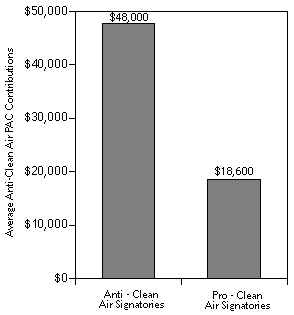
Florida has some of the cleanest air in the nation. The "Sunshine State's" air is so pure, in fact, that 66 out of 67 counties in Florida already comply with tough new Federal clean air standards for soot and ground-level ozone announced by President Clinton in July.
Florida's air pollution politics are another matter.
Tainted by more than three quarters of a million dollars ($763,000) in campaign funds from major polluters since January, 1991, 16 out of 23 members of the Florida congressional delegation have taken the surprising step of questioning the need for new air pollution rules - even though those rules pose no restrictions for all but one of Florida's 67 counties (and even this county may face no restrictions) (Table 1). Indeed, these new air standards represent a win-win deal for the state. Citizens receive the health and economic benefits of continued clean air in Florida while Florida businesses bear none of the costs of pollution reduction in other states.
Industry opponents of the new clean air standards have spent a reported $30 million so far in a nationwide lobbying campaign directed at lawmakers. Members of the Florida delegation urging a delay in the standards have received two and one half times the amount of campaign contributions from these industries than members of the delegation who support the new health standard. Nearly eighty percent of air polluter PAC money given to Florida House Members went to Representatives who now urge a delay in new clean air standards.
A review of Federal Election Commission data by the Environmental Working Group found that the 16 Florida House members who wrote President Clinton in May expressing concerns about the new standards pulled in an average of $48,000 apiece in campaign contributions since 1991 from the corporate coalition fighting the new standards. That is two and one half times the amount those same industries donated, on average, to Florida House members who support tough new clean air standards ($18,600) (Figure 1).

Introduction
In November, 1996, the U.S. Environmental Protection Agency (EPA) set off a major political battle when it proposed to update the decade-old health standards for particulate pollution (soot) and ground level ozone (smog). After an exhaustive review of more than 3,000 studies EPA Administrator Browner, along with EPA's Clean Air Science Advisory Committee, concluded that the current health standards for both soot and smog needed to be revised.
President Clinton gave final approval to the new standards in July, 1997. EPA estimated that improvements to the health standards for smog and soot would annually prevent more than 15,000 premature deaths, 350,000 cases of aggravated asthma and nearly a million cases of significantly decreased lung function in children.
The EPA acted despite significant opposition from major segments of the business community. As the National Journal reported in January, 1997, "corporate giants from the oil, chemical, electric utility and trucking industries are working together under the banner of the Air Quality Standards Coalition [AQSC] ... The coalition boasts more than 500 members and a war chest that's estimated at well over $2 million." According to press reports, that war chest grew to as much as $30 million (The Washington Post, June 17, 1997).
Air Pollution is Hard to Find in Florida
Every year, tens of millions of vacationers head to Florida for sparkling beaches, non-stop sunshine and clean, ocean-fresh air. Its healthy environment is one of the "Sunshine State's" principal attractions, and fresh air is one of Florida's biggest draws.
In fact, the state has such high-quality air that every Florida county currently meets EPA's smog and soot standards. Indeed, it is impressive that a state of Florida's size and population does not have a single county out of compliance with current EPA air standards.
Even more impressive, EPA estimates that not a single one of the state's 67 counties will fail to meet the EPA's new standard for soot, and only one county in the entire state (Escambia, a northwest panhandle county that is downwind from pollution sources, such as Mobile, Alabama) might exceed the new, more protective standard for smog.
EPA's prediction is based on air pollution data from the early 1990's. If, as expected, recent trends prevail and air quality in Florida continues to improve, it is possible that even Escambia County will meet the new standard in the year 2000 when final compliance determinations are made.
Pollution Standards and the Florida Delegation
While Florida's air is clear, its air pollution politics are not. In a May 7, 1997 letter to President Clinton, 17 of 23 Florida House members said they question the new clean air rules and urged a delay in implementation. One representative, Rep. Corrine Brown, who signed the May 7 letter, now supports the new air standards and pledges to uphold a Presidential veto of any Congressional effort to overturn them.
The May 7 letter (Appendix 1) details concerns about "imposing these mandates," on the state, adding that it would be "demoralizing" for Florida if the new standards were implemented because Florida had achieved complete compliance with the Clean Air Act in 1995. The letter claimed further that the new EPA air standards for ozone and particulate matter were "costly and potentially unnecessary."
In fact, there is no reason to believe that EPA's new standards will mandate anything at all in Florida. As noted above, the state's air is so clean that EPA expects only one county, at most, might have to take steps to comply with the standards. That is one county out of the 67 counties in the state.
Five members of the Florida House Delegation have signed letters from Representatives Waxman (D-CA) and Boehlert (R-NY) that support immediate implementation of the new standards.
If anything, timely implementation of EPA's new clean air standards is a big plus for states like Florida with clean air. The new standard will cause other states to lose the economic advantage they currently enjoy by not having to invest in pollution control technology.
At the same time, Florida citizens will save tax dollars they currently spend through Medicare and veterans hospitals addressing health impacts of air pollution across the country. Based on a full cost-benefit analysis done on the new clean air standards (that done by EPA) the new standards will save average Americans $106 billion in reduced annual mortality, health care, and productivity costs, compared to the $9.7 billion industry will annually spend to cut air pollution. This represents more than a 10 to 1 return in benefits to Americans for the investment by polluting industries.
Campaign Contributions & Clean Air Politics
Why are U.S. House members from Florida challenging the clean air standards that will require no actions by any industry in the state, and will save Florida taxpayers money? Perhaps it has something to do with PAC contributions from major air polluters.
The Environmental Working Group analyzed contributions to the Florida Congressional delegation from Air Quality Standards Coalition (AQSC)1 member corporation PACs. The contributions totaled nearly $1 million to the 23 Florida House members (Table 1 and Table 2). Of that, 79 percent or $763,000 went to members urging a delay in the standard. This averages $48,000 per member voicing concerns about the standard. In contrast, 10 percent of the total state contributions from these same polluter PACs, totalling just $93,000, went to the five Florida members supporting the standard. This averages $18,600 per member supporting the new health standard.
Summary
Blessed with pure, fresh air, Florida faces no problems complying with new Federal clean air standards. These new air standards represent a win-win deal for the state. Citizens receive the health and economic benefits of continued clean air in Florida while Florida businesses bear none of the costs.
The absence of a problem in Florida suggests that hundreds of thousands of dollars in campaign contributions from air polluters has played at least some role in encouraging 16 members of the Florida delegation urging a delay in the new clean air standards. Congressional action to delay the standards is not expected for at least several weeks.
View and Download the report here: New Clean Air Standards are No Sweat in Florida
